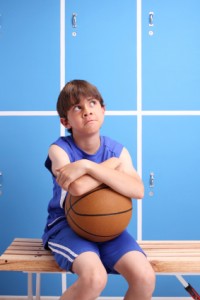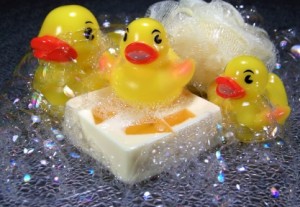Socially Awkward?
 Decades ago, showers were a required part of PE. Now, they’re an afterthought. Most athletes leave the locker room covered in their sweat—and others’—all the way home or, worse, all the way through class.
Decades ago, showers were a required part of PE. Now, they’re an afterthought. Most athletes leave the locker room covered in their sweat—and others’—all the way home or, worse, all the way through class.
“In all the years I’ve played football, I’ve never seen anyone shower in the locker room,” said high school football player Joe Eason, in an interview with the Sun Sentinel. “I just don’t feel comfortable around all of those people.”
While locker room showering has decreased, regular staph infections have increased. Drug-resistant infections commonly known as MRSA have doubled in the last five years. There are multiple drivers to the problem, and we’re not trying to say that locker room showering, or lack thereof, is the main culprit. Still, athletic trainers are certain that not showering is a poor defense against contracting a MRSA infection. And one driver is pretty clear: MRSA sources are mainly “community associated,” meaning they are spread more by person-to-person contact than by surfaces and devices.
Person-to-person contact is of course a huge problem for athletes, who unintentionally swap blood and sweat on the field and in the locker room. Three Tampa Bay Buccaneer football players fell victim to MRSA infections this fall. The resulting headlines may have expanded awareness of the disease, but hasn’t translated into a resurrection of the post-workout showering tradition. Instead, it has supported a set of new technologies that substitute for soap and water.
Soap and Water Substitutes
QwikShower Gym Class Wipes
 Like moist towelettes, they’re meant to be used on the go, and when showers “aren’t possible.” They give shy teens like Joe a way to dodge both showering and body odor. They’re also a 75-cent back-up plan for anyone who forgot their toiletries bag and towel. What’s the difference between QwikShower and a real shower? Unlike antibacterial soap or Lysol wipes, QwikShowers won’t kill germs. They also won’t wash germs off of the body as effectively as soap and hot water. (By the way, this company was started by a booster club volunteer. He runs it as a family business and donates some of the profits to local booster clubs.)
Like moist towelettes, they’re meant to be used on the go, and when showers “aren’t possible.” They give shy teens like Joe a way to dodge both showering and body odor. They’re also a 75-cent back-up plan for anyone who forgot their toiletries bag and towel. What’s the difference between QwikShower and a real shower? Unlike antibacterial soap or Lysol wipes, QwikShowers won’t kill germs. They also won’t wash germs off of the body as effectively as soap and hot water. (By the way, this company was started by a booster club volunteer. He runs it as a family business and donates some of the profits to local booster clubs.)
GTech Sports Spray
This aerosol-applied spray deodorizes and prevents bacteria growth. It might be useful for the hard-to-reach recesses of helmets and other hard padding. Students keep it in their locker room. It’s commonly sold as a fundraiser.
Germ Ninja
How do germs get from one person to another? In sports like volleyball, there’s only really one way: the ball itself. That logic inspired Germ Ninja, an ultraviolet ball sanitizer, that annihilates bacteria without harming balls. So, Germ Ninja solves part of the staph-exchange problem. However, athletic directors will want to evaluate how appropriate it is for their sports. This article about the invention, by the Denver Post, offers a balanced look at the pros and cons of the Germ Ninja.
MonoFoil
Maker Texon Athletic’s website asserts that its spray sanitizer keeps locker room surfaces sterile 90 days after application. It kills germs on surfaces the second it’s applied, and neutralizes bacteria that come into contact with those surfaces later. This Indianapolis TV interview includes a demo of the product. At 30 times the cost of conventional bleach, it’s a bit pricey. Still, it could be a good investment if it significantly cuts labor costs.
PCC Air Purification
This air filter is meant to clean locker rooms by removing odor and killing staph. We couldn’t find details about the science behind this, but you can learn more about the product in this vendor video.
These are just a few of the products that we’ve seen promoted. Many of these products are exciting because they are new. That also means that they haven’t withstood the test of time. We’d recommend researching them further to see if they fit the needs of your booster club.
[yks-mailchimp-list id=”844180b8f4″]
Why Did The Shower Disappear?
 We mentioned above that many students avoid showers in the locker room because of social awkwardness. Yet shower-shy teens don’t completely explain the cultural shift away from mandatory showering.
We mentioned above that many students avoid showers in the locker room because of social awkwardness. Yet shower-shy teens don’t completely explain the cultural shift away from mandatory showering.
- Coaches afraid of sexual harassment suits: In the wake of so many abuse scandals like the Sandusky case, it just doesn’t make sense for coaches to be pro-shower. Could abusive situations be avoided through sound policies? Strict prohibitions against coaches showering around players might prevent even the appearance of impropriety.
- Poor execution: Mandatory shower policies sound good on paper, but enforcing them resulted in a lot of humiliation. In one case, the A.C.L.U. represented overweight girl who was punished at school for refusing to open her towel to a gym teacher. Why would the teacher ask that? It was a logical way to make sure students weren’t just showering in their underwear. Despite the good and hygienic intentions of teachers and coaches, many adults can look back on embarrassing or even traumatic school gym experiences. It’s unsurprising that they let young people skip the showers.
- Feedback loop: as showering on site has become less of a priority, new facilities have less shower stalls or even no showers available. If a gym has only one or two shower heads, for example, it’s impossible to imagine an entire team showering after practice.
Common Sense Solutions
The Center for Disease Control (CDC) has practical advice on preventing staph infections. Showering right after exercise is high on the list, but there are others as well. Players should cover cuts and scrapes, and avoid sharing towels, soap, razors, or skin products. Locker room surfaces should be disinfected once per week. Those might sound like common sense, but they require a disciplined and committed coaching staff in order to be implemented.
Here’s something you might not know: staph bacteria can transfer to clothing and wait in the fibers until it jumps to a new host. It’s a good idea to wash uniforms and other equipment often. That is, not just when they become unbearably smelly. The CDC recommends washing in hot water and drying on the hottest cycle. That might be a challenge for easily damaged synthetic fibers. Another CDC tip is to avoid contact between uniforms and other upholstery. Instead of throwing those sweaty garments on the back seat or the arm of a couch, store them in plastic boxes.
Take the Lead, Start a Discussion
 Right now the germs are winning, the locker rooms are losing, and we’re just starting to fight back in the Post-Shower era. The technologies we mentioned above have potential to cut down infections. A return to showering might help as well. From the National Association for Sport and Physical Education, program manager Cheryl Richardson had this to share:
Right now the germs are winning, the locker rooms are losing, and we’re just starting to fight back in the Post-Shower era. The technologies we mentioned above have potential to cut down infections. A return to showering might help as well. From the National Association for Sport and Physical Education, program manager Cheryl Richardson had this to share:
“It would be so much easier if kids would take a shower.”
Are germs a concern for your booster club in a post-shower era? Like bacteria building up in a corner, the decline of showering has occurred without much discussion. As we mentioned above, showering can be a politically sensitive topic for athletic directors and coaches. However, parents can discuss the issue from another angle, and might be better positioned to take the lead on discussions about hygiene. We hope that this blog post helps spark those discussions. Please share with your fellow volunteers on Facebook, Twitter, or your club newsletter to get the conversation started.
READ MORE
6 Volunteer Recruitment Tips
93 Fundraising Ideas
501(c)(3) Nonprofit Status Explained



